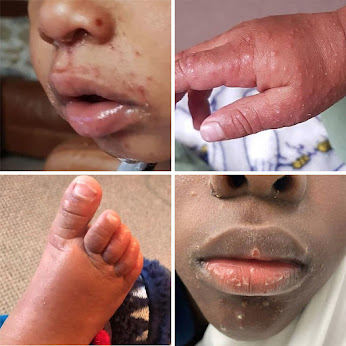Hand, Foot, and Mouth Disease (HFMD) is a viral infection that stimulate a rash or blisters on the hands and feet, as well as in or around the mouth. Two types of virus mainly cause HFMD, and the symptoms vary depending on the virus.
It primarily affects children under the age of 10, but can also affect adolescents. It spreads easily from one kid to another. It is possible to get the virus more than once, but the symptoms will be less severe.
It is most commonly caused by the Coxsackie virus from the Enterovirus genus. It spreads primarily from inside the blisters, or with the droplets spread from sneezing and/or coughing. The virus can also be present in bowel movements for up to several weeks after the child has recovered.
Signs and Symptoms
Symptoms usually start 3-7 days after becoming infected and can last from 7-10days. If your child has this infection, they may feel tired, have a fever, and have a rash. Depending on which kind of virus your child has, the rash on the skin can look like this;
Small, oval, white blisters on the palms, soles of the feet, as well as in mouth. Your child may have a sore throat, leading to poor appetite or risk of dehydration
A red skin rash with a brown scale on it and the rash may appears on the outer arms, hands, legs, and feet around the mouth and upper buttocks. The trunk is usually relatively clear but sometimes, there may be blisters present they are not usually in the mouth and your child can eat and drink as usual.
Treatment
In most instances, the infection will go away without treatment in 7 to 10 days. However, your healthcare provider may recommend certain treatments to help ease symptoms until the disease has run its course and these may include;
- Over-the-counter or prescription topical ointments to soothe blisters and rashes
- Pain medication, such as paracetamol or ibuprofen, to relieve headaches
- Medicated syrups or lozenges to help ease painful sore throats
Prevention
Doing these little things can help prevent the spread of HFMD among children and these include;
- Making sure your kid doesn't share items such as cutlery, drinking cups, towels, toothbrushes, and clothing
- Keeping your child home from school, kindergarten, or childcare until all the fluid in their blisters has dried
- Washing your hands thoroughly after touching your child's bodily fluids includes touching their blisters, helping them blow their nose, and changing nappies or helping with toileting
Care at Home
HFMD is a viral infection that seldom causes further complications. Antibiotics don't work on viruses and should not be given to kids with HFMD. It will get much better on its own, but there are still ways you can care for your child at home:
- If your child is in pain or is uncomfortable, you can give them pain medication such as paracetamol or ibuprofen. DO NOT GIVE ASPIRIN
- Give your child frequent sips of water or an oral rehydration solution to stop them from becoming dehydrated
- Leave blisters to dry naturally. Do not pierce or squeeze them
- Gargling warm salt water around the mouth may also help relieve the pain that is associated with mouth blisters and throat sores. Your kid can do this several times a day or as often as needed
In Conclusion, You or your child should feel completely better 7-10 days after the initial onset of symptoms. Getting the infection again is uncommon as the body usually builds up immunity to the viruses that cause the disease.
Call your healthcare provider immediately if symptoms get worse or don't clear up within 10 days. In rare cases, the Coxsackie virus can cause a medical emergency. Potential complications may include;
- Dehydration
- Fingernail or toenail loss\
- Viral meningitis
- Encephalitis
- Paralysis
- Myocarditis
Dr. Favvy
Has this post been helpful to you?
Kindly drop your comments, questions, and suggestions on our Facebook page
https://www.facebook.com/dr.favvy
We are open for consultation!!!
Drop a message on our Facebook page
https://www.facebook.com/dr.favvy


Comments
Post a Comment